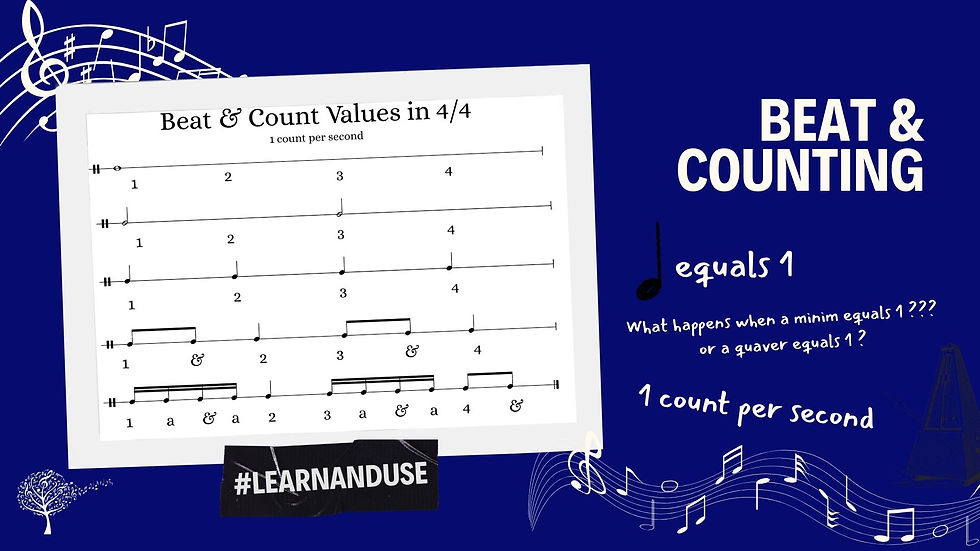Decoding Rhythmic Time Names in Elementary Music: A Guide for Students and Parents
- 17 hours ago
- 4 min read
Updated: 38 minutes ago
Learning music can feel like learning a new language, and in elementary music education, you might hear some unique terms, especially when it comes to rhythm. One common system, particularly in methods like Kodály, uses what are called "French Time Names" or "French Rhythmic Names." These aren't just fancy words; they're a clever way to help young musicians understand and feel different rhythmic values. In the TQ system we have adjusted the name to reflect the fact the pronunciation is not as per the French language but shows the adjustments of many music teachers and accents over a century of use.
This blog post will break down what Rhythmic Time Names are, why they're used, and how they benefit students and parents navigating the world of elementary music lessons.
What Are Rhythmic Time Names?
These words for a syllable-based rhythmic system for learning note values are syllables assigned to different note durations to help students vocalize and internalize rhythmic patterns. Instead of just seeing a quarter note or an eighth note on the page, students learn to say a specific syllable that corresponds to that note's length. This makes abstract concepts like duration much more concrete and accessible, especially for young learners who are still developing their musical literacy.
Here are some of the most common Rhythmic Time Names you'll encounter:
The first set of three note values use the long a sound shown phonetically as /ɑ/ and sounded as the a in father. When a vowel is stressed and pronounced with a relaxed jaw and tongue position. The 'Ta' syllable is a sustained sound for longer notes.
Whole Note: "Ta-a-a-a" (often stretched over four beats)
Dotted Half Note: "Ta-a-a" (stretched over two beats)
Half Note: "Ta-a" (stretched over two beats)
Quarter Note: "Ta" (one beat)
The second set of three note values use the short a sound shown phonetically as /ă/ and sounded as the a in cat,sat, mat. To make this sound open your mouth relatively wide with the tongue low in your mouth and resting against the back of your lower teeth.
The i sound is a short i shown phonetically as /ɪ/ and can be heard in lit and sit. This sound is a high-front sound. Tongue should be high in mouth, shifted front, lips relaxed and slightly open. The 'Ti' syllable is a quick, clipped sound for shorter notes.
Paired Eighth Notes: "Tă-Ti" (two eighth notes together, each half a beat)
Single Eighth Note: "Ti" (half a beat, often paired with a rest or another eighth note)
Four Sixteenth Notes: "Tăfi-Tifi" (each a quarter of a beat)
Why Do We Use French Time Names?


Why Do We Use Rhythmic Time Names?
There are several compelling reasons why music educators incorporate Rhythmic Time Names:
1. Concrete Representation of Abstract Concepts
Rhythm can be challenging to grasp. Rhythmic Time Names provide a phonetic and kinesthetic way for students to embody the length of notes. Saying "Ta" for a quarter note or "Ta-Ti" for eighth notes helps them feel the duration in their voice and body, making the concept less abstract.
2. Aid to Aural Skills Development
By vocalising rhythms with these syllables, students strengthen their aural skills. They learn to hear and differentiate between various rhythmic patterns, which is a fundamental part of musical training.
3. Foundation for Reading Music
Before students can read complex rhythms on the staff, they need a strong internal understanding of duration. Rhythmic Time Names serve as a bridge, allowing them to perform and understand rhythms before they even learn to read all the notation. This builds confidence and makes the transition to formal notation smoother.
4. Group Learning and Engagement
Using common syllables allows students to perform rhythms together in a unified way. It fosters a sense of ensemble and makes rhythmic activities more engaging and interactive.
5. Cross-Cultural Connection
While commonly known as "French Time Names," variations of this concept are used in music education globally, particularly in methods influenced by Zoltán Kodály. This indirectly connects students to a broader tradition of music pedagogy.
How Parents Can Support at Home
Parents play a crucial role in reinforcing what students learn in their music lessons. Here's how you can help with French Time Names:
Ask Your Child to Demonstrate: Encourage your child to show you the different Rhythmic Time Names they've learned. Ask them to clap and say the rhythms.
Practice with Everyday Sounds: Point out rhythms in everyday life – the ticking of a clock ("Ta, Ta, Ta"), the beat of a song on the radio ("Ta-Ti, Ta, Ta-Ti, Ta"), or even the way you walk. Try to connect these sounds to the Rhythmic Time Names.
Incorporate into Play: Turn rhythm practice into a game. Clap out simple patterns and have your child identify the French Time Names, or vice versa.
Review Class Materials: If your child's teacher provides handouts or online resources, review them together. This shows your support and reinforces the learning.
Be Patient and Positive: Learning music takes time and practice. Celebrate small victories and maintain a positive attitude towards their musical journey.
Conclusion
Rhythmic Time Names are a powerful tool in elementary music education, simplifying complex rhythmic concepts for young learners. By understanding these syllables, students develop a strong foundation in rhythm, enhance their aural skills, and build confidence in their musical abilities. For parents, a little understanding and encouragement at home can go a long way in supporting your child's musical growth. Embrace the "Ta's" and "Ta-Ti's" – they're the building blocks of a lifelong appreciation for music!




